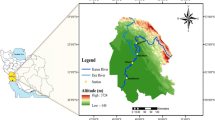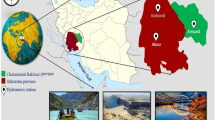Abstract
Rivers, as the most prominent component of water resources, have a key role to play in increasing the life expectancy of living creatures. The essential characteristics of water pollutants can be described by water quality indices (WQIs). Hence, a ferocious demand for obtaining an accurate prediction of WQIs is of high importance for perception of pollutant patterns in natural streams. Field studies conducted on different rivers indicated that there is no general relationship to yield water quality parameters with a permissible level of accuracy. Over the past decades, several artificial intelligence (AI) models have been employed to predict more precise estimation of WQIs rather than conventional models. In this way, through the current study, multivariate adaptive regression spline (MARS) and least square-support vector machine (LS-SVM), as machine learning methods, were used to predict indices of the five-day biochemical oxygen demand (BOD5) and chemical oxygen demand (COD). To improve the proposed approaches, 200 series of field data, collected from Karoun River southwest of Iran, pertain to the nine independent input parameters, namely electrical conductivity (EC), sodium (Na+), calcium (Ca2+), magnesium (Mg2+), orthophosphate (\( {\mathrm{PO}}_4^{3-} \)), nitrite (\( {\mathrm{NO}}_2^{-} \)), nitrate nitrogen (\( {\mathrm{NO}}_3^{-} \)), turbidity, and pH. The performances of the LS-SVM and MARS techniques were quantified in both training and testing stages by means of several statistical parameters. Furthermore, the results of the proposed AI models were compared with those obtained using artificial neural network (ANN), adaptive neuro-fuzzy inference system (ANFIS), and multiple regression equations. Results of the present research work indicated that the proposed artificial intelligence techniques, as machine learning classifiers, were found to be efficient in order to predict water quality parameters.






Similar content being viewed by others
References
Adnan, R. M., Yuan, X., Kisi, O., & Yuan, Y. (2017a). Streamflow forecasting using artificial neural network and support vector machine models. American Scientific Research Journal for Engineering, Technology, and Sciences (ASRJETS), 29(1), 286–294.
Adnan, R. M., Yuan, X., Kisi, O. and Anam, R. (2017b). Improving accuracy of river flow forecasting using LSSVR with gravitational search algorithm. Advances in Meteorology, 2017.
Alizadeh, M. J., & Kavianpour, M. R. (2015). Development of wavelet-ANN models to predict water quality parameters in Hilo Bay, Pacific Ocean. Marine Pollution Bulletin, 98(1), 171–178.
Asadollahfardi, G., Taklify, A., & Ghanbari, A. (2012). Application of artificial neural network to predict TDS in Talkheh Rud River. Journal of Irrigation and Drainage Engineering, 138(4), 363–370.
Azamathulla, H. M., & Ghani, A. A. (2011). Genetic programming for predicting longitudinal dispersion coefficients in streams. Water Resources Management, 25(6), 1537–1544.
Basant, N., Gupta, S., Malik, A., & Singh, K. P. (2010). Linear and nonlinear modeling for simultaneous prediction of dissolved oxygen and biochemical oxygen demand of the surface water—a case study. Chemometrics and Intelligent Laboratory Systems, 104(2), 172–180.
Chau, K., & Wu, C. (2010). A hybrid model coupled with singular spectrum analysis for daily rainfall prediction. Journal of Hydroinformatics, 12(4), 458–473.
Chen, Z., Shi, R., & Zhang, S. (2013). An artificial neural network approach to estimate evapotranspiration from remote sensing and AmeriFlux data. Frontiers of Earth Science, 7(1), 103–111.
Chen, X., Chau, K., & Busari, A. (2015). A comparative study of population-based optimization algorithms for downstream river flow forecasting by a hybrid neural network model. Engineering Applications of Artificial Intelligence, 46, 258–268.
Cortes, C., & Vapnik, V. (1995). Support vector networks. Machine Learning, 20, 273–297.
Deininger, R. A., Lee, J., & Clark, R. M. (2011). Rapid detection of bacteria in drinking water and water contamination case studies. Frontiers of Earth Science, 5(4), 378–389.
Dogan, E., Sengorur, B., & Koklu, R. (2009). Modeling biological oxygen demand of the Melen River in Turkey using an artificial neural network technique. Journal of Environmental Management, 90(2), 1229–1235.
Ebtehaj, I., & Bonakdari, H. (2014). Performance evaluation of adaptive neural fuzzy inference system for sediment transport in sewers. Water Resources Management, 28(13), 4765–4779.
Emamgholizadeh, S., Kashi, H., Marofpoor, I., & Zalaghi, E. (2014). Prediction of water quality parameters of Karoon River (Iran) by artificial intelligence-based models. International Journal of Environmental Science and Technology, 11(3), 645–656.
Fallah-Mehdipour, E., Bozorg Haddad, O., & Mariño, M. (2013). Prediction and simulation of monthly groundwater levels by genetic programming. Journal of Hydro-Environment Research, 7(4), 253–260.
Feng, C., Wu, F., Zhao, X., Li, H., & Chang, H. (2012). Water quality criteria research and progress. Science China Earth Sciences, 55(6), 882–891.
Gandomi, A. H., Alavi, A. H., Sahab, M. G., & Arjmandi, P. (2010). Formulation of elastic modulus of concrete using linear genetic programming. Journal of Mechanical Science and Technology, 24(6), 1273–1278.
Gholami, V., Chau, K., Fadaee, F., Torkaman, J., & Ghaffari, A. (2015). Modeling of groundwater level fluctuations using dendrochronology in alluvial aquifers. Journal of Hydrology, 529, 1060–1069.
Golbraikh, A., & Tropsha, A. (2002). Beware of q2! Journal of Molecular Graphics & Modelling, 20(4), 269–276.
Hair, J. F., Anderson, R. E., Tathan, R. L., & Black, W. (1995). Multivariate data analysis with readings. 4th edn. Englewood Cliffs: Prentice Hall.
Heddam, S., & Kisi, O. (2018). Modelling daily dissolved oxygen concentration using least square support vector machine, multivariate adaptive regression splines and M5 model tree. Journal of Hydrology, 559, 499–509.
Jang, J. S. R. (1993). ANFIS: adaptive-network-based fuzzy inference system. IEEE Transactions on Systems, Man, and Cybernetics, 23, 665–685.
Jang, J. S. R., Sun, C. T., & Mizutani, E. (1997). Neuro-fuzzy and soft computing: a computational approach to learning and machine intelligence. Upper Saddle River: Prentice Hall.
Kisi, O. (2015). Pan evaporation modeling using least square support vector machine, multivariate adaptive regression splines and M5 model tree. Journal of Hydrology, 528, 312–320.
Kumar, P. S., Praveen, T., & Prasad, M. A. (2016). Artificial neural network model for rainfall-runoff—a case study. International Journal of Hybrid Information Technology, 9(3), 263–272.
Laucelli, D., & Giustolisi, O. (2011). Scour depth modelling by a multi-objective evolutionary paradigm. Environmental Modelling and Software, 26(4), 498–509.
Laucelli, D., Berardi, L., Doglioni, A. and Giustolisi, O. (2012). EPR-MOGA-XL: an excel based paradigm to enhance transfer of research achievements on data-driven modeling. Proceedings of 10th international conference on hydroinformatics HIC 2012, 14-18 July, Hamburg, Germany, R. Hinkelmann, M.H. Nasermoaddeli, S.Y. Li-ong, D. Savic, P. Fröhle (Eds).
Li, X., Sha, J. and Wang, Z.L (2016). A comparative study of multiple linear regression, artificial neural network and support vector machine for the prediction of dissolved oxygen. Hydrology Research, nh2016149.
Mahmoudi, N., Orouji, H., & Fallah-Mehdipour, E. (2016). Integration of shuffled frog leaping algorithm and support vector regression for prediction of water quality parameters. Water Resources Management, 30(7), 2195–2211.
Mattar, M. A., & Alamoud, A. I. (2015). Artificial neural networks for estimating the hydraulic performance of labyrinth-channel emitters. Computers and Electronics in Agriculture, 114, 189–201.
Mohammadpour, R., Shaharuddin, S., Chang, C. K., Zakaria, N. A., & Ab-Ghani, A. (2014). Spatial pattern analysis for water quality in free surface constructed wetland. Water Science and Technology, 70(7), 1161–1167.
Mohammadpour, R., Shaharuddin, S., Zakaria, N., Ghani, A., Vakili, M., & Chan, N. (2016). Prediction of water quality index in free surface constructed wetlands. Environmental Earth Sciences, 75(2), 1–12.
Najafzadeh, M., Laucelli, D. B. and Zahiri, A. (2016). Application of model tree and evolutionary polynomial regression for evaluation of sediment transport in pipes. KSCE Journal of Civil Engineering, 1–8.
Noori, R., Karbassi, A., Farokhnia, A., & Dehghani, M. (2009). Predicting the longitudinal dispersion coefficient using support vector machine and adaptive neuro-fuzzy inference system techniques. Environmental Engineering Science, 26(10), 1503–1510.
Noori, R., Karbassi, A., Moghaddamnia, A., Han, D., Zokaei-Ashtiani, M., Farokhnia, A., & Gousheh, M. G. (2011). Assessment of input variables determination on the SVM model performance using PCA, gamma test, and forward selection techniques for monthly stream flow prediction. Journal of Hydrology, 401(3), 177–189.
Noori, R., Karbassi, A., Ashrafi, K., Ardestani, M., Mehrdadi, N., & Bidhendi, G. R. N. (2012). Active and online prediction of BOD 5 in river systems using reduced-order support vector machine. Environmental Earth Sciences, 67(1), 141–149. https://doi.org/10.1007/s12665-011-1487-9.
Noori, R., Deng, Z., Kiaghadi, A., & Kachoosangi, F. T. (2015a). How reliable are ANN, ANFIS, and SVM techniques for predicting longitudinal dispersion coefficient in natural rivers? Journal of Hydraulic Engineering, 142(1), 04015039. https://doi.org/10.1061/(ASCE)HY.1943-7900.0001062.
Noori, R., Yeh, H. D., Abbasi, M., Kachoosangi, F. T., & Moazami, S. (2015b). Uncertainty analysis of support vector machine for online prediction of five-day biochemical oxygen demand. Journal of Hydrology, 527, 833–843. https://doi.org/10.1016/j.jhydrol.2015.05.046.
Olyaie, E., Banejad, H., Chau, K.-W., & Melesse, A. M. (2015). A comparison of various artificial intelligence approaches performance for estimating suspended sediment load of river systems: a case study in United States. Environmental Monitoring and Assessment, 187(4), 189.
Orouji, H., Bozorg Haddad, O., Fallah-Mehdipour, E., & Mariño, M. (2013). Modeling of water quality parameters using data-driven models. Journal of Environmental Engineering, 139(7), 947–957.
Rahimikhoob, A. (2016). Comparison of M5 model tree and artificial neural network’s methodologies in modelling daily reference evapotranspiration from NOAA satellite images. Water Resources Management, 30(9), 3063–3075.
Roy, P. P., & Roy, K. (2008). On some aspects of variable selection for partial least 684 squares regression models. QSAR and Combinatorial Science, 27(3), 302–313.
Sattar, A. M. (2014). Gene expression models for the prediction of longitudinal dispersion coefficients in transitional and turbulent pipe flow. Journal of Pipeline Systems Engineering and Practice, 5(4013011), 1–10.
Singh, K. P., Basant, A., Malik, A., & Jain, G. (2009). Artificial neural network modeling of the river water quality—a case study. Ecological Modelling, 220(6), 888–895.
Singh, K. K., Pal, M., & Singh, V. P. (2010). Estimation of mean annual flood in Indian catchments using backpropagation neural network and M5 model tree. Water Resources Management, 24(10), 2007–2019.
Smith, M. (1994). Neural networks for statistical modelling (p. 245). New York: Van Nostrand Reinhold.
Sreekanth, J., & Datta, B. (2011). Comparative evaluation of genetic programming and neural network as potential surrogate models for coastal aquifer management. Water Resources Management, 25(13), 3201–3218.
Suykens, J. A., & Vandewalle, J. (1999). Least squares support vector machine classifiers. Neural Processing Letters, 9(3), 293–300.
Taormina, R., Chau, K.-W., & Sivakumar, B. (2015). Neural network river forecasting through baseflow separation and binary-coded swarm optimization. Journal of Hydrology, 529, 1788–1797.
Verma, A., & Singh, T. (2013). Prediction of water quality from simple field parameters. Environmental Earth Sciences, 69(3), 821–829.
Wang, W.-C., Chau, K.-W., Xu, D.-M., Qiu, L., & Liu, C.-C. (2017). The annual maximum flood peak discharge forecasting using Hermite projection pursuit regression with SSO and LS method. Water Resources Management, 31(1), 461–477.
Xu, J., Chen, Y., Li, W., Peng, P. Y., Yang, Y., Wei, C., & Hong, Y. (2013). Combining BPANN and wavelet analysis to simulate hydro-climatic processes—a case study of the Kaidu River, North-west China. Frontiers of Earth Science, 7(2), 227–237.
Yaseen, Z. M., Ramal, M. M., Diop, L., Jaafar, O., Demir, V., & Kisi, O. (2018). Hybrid adaptive neuro-fuzzy models for water quality index estimation. Water Resources Management., 32(7), 2227–2245.
Zhang, W. G., & Goh, A. T. C. (2013). Multivariate adaptive regression splines for analysis of geotechnical engineering systems. Computers and Geotechnics, 48, 82–95.
Author information
Authors and Affiliations
Corresponding author
Additional information
Publisher’s note
Springer Nature remains neutral with regard to jurisdictional claims in published maps and institutional affiliations.
Rights and permissions
About this article
Cite this article
Najafzadeh, M., Ghaemi, A. Prediction of the five-day biochemical oxygen demand and chemical oxygen demand in natural streams using machine learning methods. Environ Monit Assess 191, 380 (2019). https://doi.org/10.1007/s10661-019-7446-8
Received:
Accepted:
Published:
DOI: https://doi.org/10.1007/s10661-019-7446-8




